Interview: Ed Piskor on Illustrating The Hip Hop Family Tree
If all you knew about Ed Piskor was his occupation, his main fields of interest and his creative buddies, you might envision a soon-to-be-bald, reclusive brainiac, trying to come to terms with the subcultures of his own past. “I get this all the time,” he laughs when confronted with these admittedly ignorant assumptions.
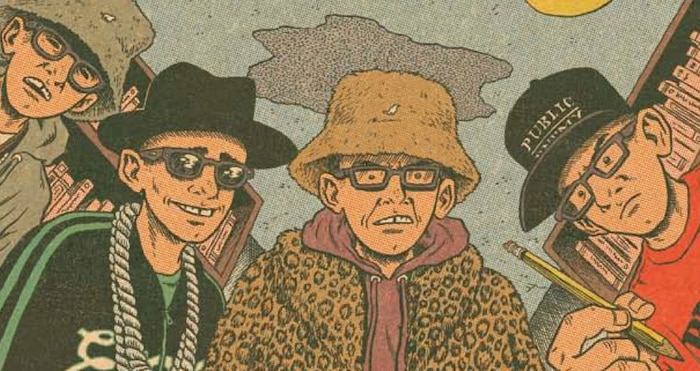
In fact, Ed Piskor has only recently entered his third decade, and is far from being bitter. Growing up in Pittsburgh, PA, at a time when the Steel City was hit hard by the decline of its main industrial branch, Piskor started publishing small underground comics at a young age. Undeniably gifted, Piskor attended the Kubert School, and earned early underground success with his mini-series Deviant Funnies and Isolation Chamber, as well as his collaborative efforts with Jay Lynch.
Piskor’s standing in the comic scene changed dramatically, though, when he received a call from Harvey Pekar, the infamous comic auteur whose painfully realist series American Splendor transformed its writer into a globally recognizable face (frequent appearances on Letterman, and an acclaimed biopic starring Paul Giamatti included). Pekar and Piskor went on to write a finely researched graphic history of the literary outlaws of the Beat Generation before Piskor dug deep into the dimly-lit underworld of computer hacking for his first big solo endeavour Wizzywig – Portrait of a Serial Hacker. The Hip Hop Family Tree, Piskor’s current series, is another take on that very special late ‘70s/ early ‘80s aesthetic. It is also a meticulously crafted history of early hip hop culture and its main protagonists, told with great empathy and humour.
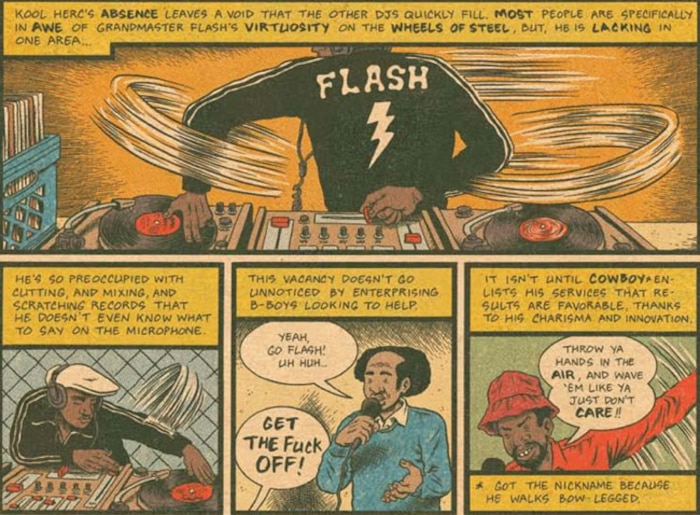
Who is the company you’re working with on The Hip Hop Family Tree?
Fantagraphics. They publish pretty much the best stuff in America, basically. They have the license to do reprint volumes of the Peanuts comics, they also do Robert Crumb and everything in between… As for The Hip Hop Family Tree project, I just knew it would turn out pretty cool, because a lot of people were coming at me trying to publish it. So I had the option to see who I wanted to go with. Ultimately I wanted the book to look in a very specific way, and a lot of the companies didn’t quite see my exact vision. But Fantagraphics never said no, so the final book is exactly what I wanted. That’s why I worked with them, it wasn’t out of monetary gain or anything like that… It was more: If we’re gonna kill trees these days to make books, it better be the best looking books that we can.
I guess you could compare it to pressing vinyl, which has become more of a prestige object… I’m asking of course, because most of your stuff can also be enjoyed online, way ahead of any physical release.
“I’d rather be listening to The Ramones... That’s a more compelling story to me than somebody who is able to walk through doors that were already busted open.”
Right, I’m still acclimated to the old way of doing things. And when I was a kid, the ultimate goal was always to have a book. But I also don’t want anybody to have the book and regret buying it. I put everything that I do online for free, so you can have the option and read it there. And if you want to, like, really help and support the project, and see my true vision realized, you have the option to get the book, too. But the comics will always be available for free online. Especially for this project, I did not realize that it’s gonna be released as a full, cohesive book until these one-page cartoons came out more and more frequently. I also don’t enjoy looking at the screen to read myself, really.
How does the drawing translate to the screen? Even for writers it can make a significant change to experience your words printed.
It’s totally different! But the reading experience is different, as well. Because when you think about reading a comic book, you’re dealing with these two-page spreads on the left and right, and when you’re reading one of my comics online, you’re in this process of just scrolling downwards…. so you’re seeing the words before you see the image. And that can get tricky. You have to be pretty conservative with your compositions because there’s a potential of the story not reading clearly. So that’s a consideration, but my philosophy lately has been to just deliver the work in whatever means people wanna absorb it. There’s generations of kids younger than me who’ve always grown up reading things on screen, they have no problem with it. But it certainly isn’t that interesting to me.
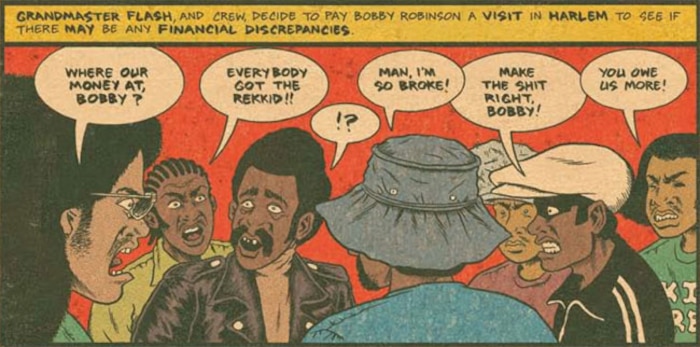
Would you consider yourself a nostalgic person?
Uhm… I, I guess. The comic that I did before this was a comic called Wizzywig about computer hacking. And that was tied-up in the ’80s [too]. I suppose I have some nostalgic whims for things like that. But I think what it’s more like is, I like to get to the root of whatever it is that I experience or I’m indulging in. I’m not so keen on derivative works. I’d rather be listening to The Ramones than whatever punk band is out now, simply because I like the story behind the idea of being unpopular. That’s a more compelling story to me than somebody who is able to walk through doors that were already busted open.
It can be quite challenging to say whether you find something current just interesting, or if it will have some worthwhile effect on your specific life, or the cultural canon, at that...
Exactly, and only after a certain amount of time you can draw these distinct lines between this event and that event which helped to create this next thing that happened, y’know? And you can see very clearly how these movements can build what it took to create these phenomenons. That is really exciting for me. Being a cartoonist you sit around all day drawing comics, and it’s a really solitary kind of play, and you have to almost trick your brain into remaining inspired. The way that I do that is, I like to read about people who overcome obstacles to create vibrant, interesting pieces of work. That’s also something about my love for hip hop, I just love that idea of people in a very destitute part of America, who really had nothing, and then they just built this really huge culture. I mean, it would be silly to call hip hop a subculture at this point. It’s an exciting thing to research and read about.
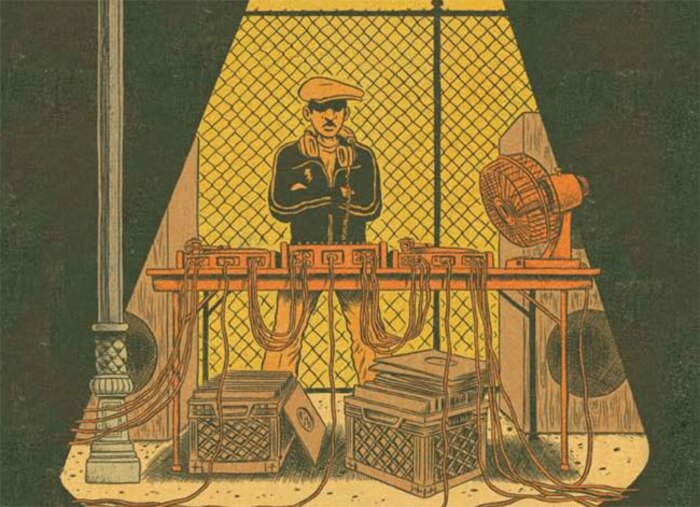
You grew up in Pittsburgh, in a mixed racial environment, correct?
Yeah, that is certainly correct.
You once described your bewilderment with the fact, that race at one point became an issue amongst you and your school friends. I was wondering what exact incident you were referring to...
“I mean, imagine as a kid! The bright colors of graffiti, guys spinning on their heads… this is visceral imagery for a child.”
I was thinking about why that even became a topic, yeah, because there was such a rapid change. You leave school at one year, and everybody is friends and then you come back and things have changed, and those racial distinctions are certainly made more clear. I was trying to deconstruct what the heck was going on in that period of time and then I realized that a big issue was the OJ Simpson trial. That was maybe the major decisive incident that happened in American culture at that time. I was kind of ignorant to it. I mean, I understood it was going on but I was just a kid, pretty much living in my own world. My friends who happened to be black, they were very conscious of these white cops using racial slurs, even in terms of that case. They were way more sensitive to these factors, which is totally understandable to me now. But I didn’t understand it at the time. I was just very confused, like “Hey, we were friends, like, a month ago. What the heck happened?”
Did your love of hip hop actually start before your “discovery” of race as a term of relevance in your life?
I was always into it, yes. I was born in 1982, so at that point hip hop was taking the country by storm. You would watch commercials and there would be breakdancers, and all these things. Where my house was situated it was in between three different playgrounds, and at any given time there was some hip hop-related action going on at all of those playgrounds. Guys circling in a rap cypher, rhyming for each other, waiting for the next chance to play basketball, or there would just be pseudo b-boy parties, people spinning on their heads on refrigerator cartons. So it was always around me. It was nothing I had to seek out, it was just there.
It was something I liked... I mean, imagine as a kid! The bright colors of graffiti, guys spinning on their heads… this is visceral imagery for a child. And being brought up in it, it was as exciting as watching acrobatics or… whatever [laughs], it was exciting! Now, getting a little bit older, it’s started to seep in, like whoa... I started to understand the social dynamics of the neighborhood. And to see these drug dealers with their big, doofy rope chains and shit like that. They looked like Eric B. & Rakim, who I knew from TV! So these guys must be cool. There was something about this badass urban superhero stuff. These were the coolest guys.
Many European scenes discovered hip hop with the first breakdance wave coming over from the states through the TV. And I’m sure, the “otherwordliness,” or some weird form of exoticism played into its attraction. For you it was different, as it was practically happening right around you, I guess…
“I said, ‘Did you understand one word?’ And my Dad was like, ‘Son, I have no idea what the hell they’re saying but I’m happy, when you’re happy.’”
Yeah, certainly not to the extent of New York City, but it was all around and it was a popular thing. However there was also an element of subversion. Because: I am white. And even people in my family were like, what are you saying? They were not even calibrated to understand the words. Just very recently Public Enemy was inducted to The Rock and Roll Hall of Fame and they gave a performance at that ceremony. You gotta understand, whenever I’m out – every single shirt I have is a Public Enemy shirt, basically. So my dad was receptive to this. He recorded the performance and told me to come over and check it out. So I watched the performance, he was there too. I was having a ball, I loved it and looking at my dad I said, “Did you understand one word?” And he’s like, “Son, I have no idea what the hell they’re saying but I’m happy, when you’re happy.” [laughs] And this is 2013. In 1984 when it was even fresher and newer, my folks thought it was alien. But for a kid growing up where I’m from, you don’t know any different. You don’t know a time before it. Still, I just liked the idea of it antagonizing stuffy white people. That became pretty exciting as a bratty child. I maintained a love for it, even if I’ve done a sort of academic study of the culture. But a component of brattiness and antagonism was certainly an extra allure when I was a child.
Did you play any active role in the hip hop scene that surrounded you? It would be an easy guess to assume you were into graffiti.
I did graffiti, and I was no good at it. Plus: I was never hard enough. There’s a lot of violence and stuff that would happen when people catch you in the train tracks. And… I, I am a big, skinny nerd! I’m not looking to fight, I’m not looking for hassle, I’m not looking for stress. So what I did as a teenager was run a website for graffiti in Pittsburgh. I went to all the key locations, take photos and post it online, and share it that way. That was my contribution. It just seems that my contribution to this culture is more of a behind-the-scenes role. I don’t have to put myself out there physically to contribute to the conversation. I certainly can’t dance or rhyme, but maybe I can contribute to the conversation with a comic book.
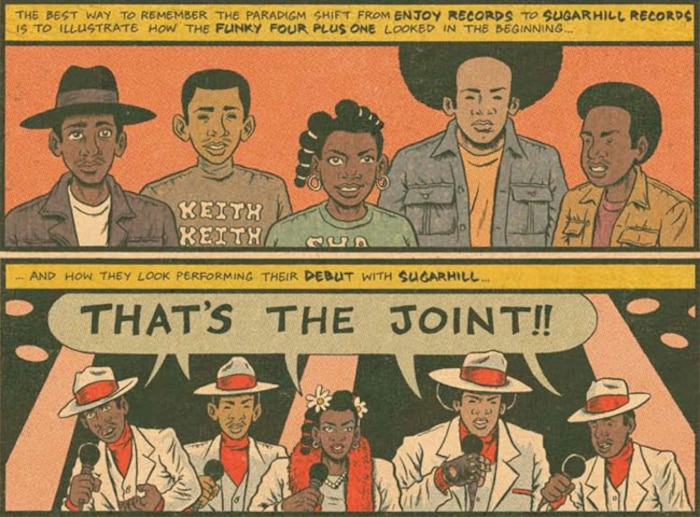
Being a cartoonist requires several dimensions of storytelling. The main focus of the narratives you choose to work on are people. The bigger books you’ve worked on so far, especially The Beats and The Hip Hop Family Tree, are character-driven rather than plot-driven, and deal with folks and anecdotes that actually existed. What is so fascinating about that?
I’m just incredibly fascinated by real life people. That’s not to say I won’t extend my fictional work in the future but I’m very inspired by the stories of dynamic, real-life personalities. All of my friends I keep closest are very dynamic people and they make things happen and they really contribute rather than just consume. And The Hip Hop Family Tree it’s… I’m a fan of rap music, no doubt. But the comic isn’t even about rap music. It’s really about community and people overcoming obstacles and rising above them. Working together to create a better situation or to be happier. It’s all this more spiritual stuff that intrigues me.
“The comic isn’t even about rap music. It’s really about community and people overcoming obstacles and rising above them.”
I relate a lot to the early hip hop scene in terms of the economic part of it. When I was born, the main economic source of the area that I’m from, the steel industry, was done. And both my parents worked in those steel mills and had no jobs. So, the people in the Bronx figured that, “OK, we don’t have musical instruments so we’re gonna loop these drum breaks and rhyme on top of it.” I, however, had access to pens and pencils rather than any expensive toys or sports that demanded health insurance. So trying to occupy my own time, I could relate to the early scene. That’s a hook that intrigues me. And to watch the story continuously build, and to watch these people create a new thing that would lead to something bigger and bigger, it’s almost like a definition of virus or bacteria, something that exponentially multiplies. It’s really fun to examine something that came from such a humble place to become this great thing.
It’s striking how much you stick with these humble beginnings. You don’t fast forward into the future of multi-million sellers such as Run-D.M.C. or Beastie Boys. Focusing on the naiveté and the innocence of those early years makes The Hip Hop Family Tree much more of an outsider story than a success story.
Well, it’s only the start of a series of books. The first one is out this November, the second volume will be out next summer. And then I will try to put one out every year until I’m done. I’m not sure I will ever catch up with the present day, as creating these books is such a slow process. But I wanna stick to it for as long as it remains interesting. And it still is incredibly fun. In my estimation these five books will probably finish around the time of Scott La Rock’s death, maybe a little bit after. The value of Fantagraphics letting me do whatever I want is that I can really zero in on these moments. Some of these companies that were interested in my work wanted me to get from Kool DJ Herc to the death of Tupac in 250 pages. That’s idiotic. Let somebody else do that. I depict a story full of happy accidents, and lots of luck, y’know.
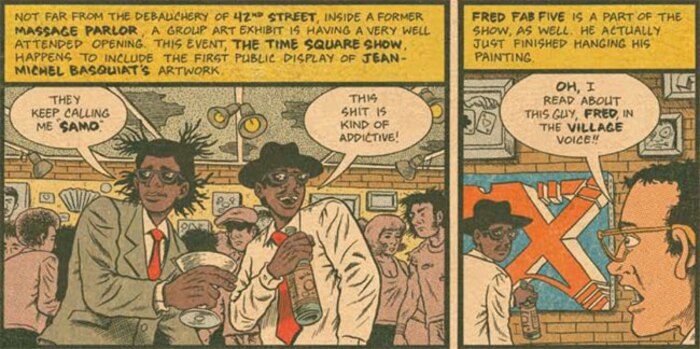
Some of these stories have been told before and clearly belong in a book like yours, I’m thinking of Melle Mel and the recording of “The Message,” or the story of the Sugarhill Gang. Others are less obvious, like when Basquiat met Rammellzee. How did you filter these anecdotes? And what are your main sources for your research?
The starting point for the whole project was ego trip's Book of Rap Lists. They have, for example, a list of singles made between 1979 - 1988 or something. That gives me a good structure for what definitely needs to be covered during these times. Now I focus on each individual single and read as many interviews, articles and books about the subject that I can, and treat these records as real moments in time, landmark events. There are also very helpful documentaries, some from the BBC, and I’ll take all of that information and seriously think about it for a while. Usually with these interviews there are a few sentences in there that are just extremely visual and lead themselves to good comic book imagery.
As for the way that I structured the book, if there’s material that could be hearsay, or spoken from a point of view that might be just conjecture, I try to make that come across in the comic. You mentioned that Rammellzee, Basquiat “Beat Bop” thing. There is not so much information about that incident and unfortunately the two guys who made that record are no longer with us, but Rammellzee left a couple of really steaming interviews, so I don’t know if that was sour grapes or what the situation was like back then. So the way that I absolve myself from being the person to say how it really was is that I put the theory in Rammellzee’s voice so that it corresponds with the research that I did.
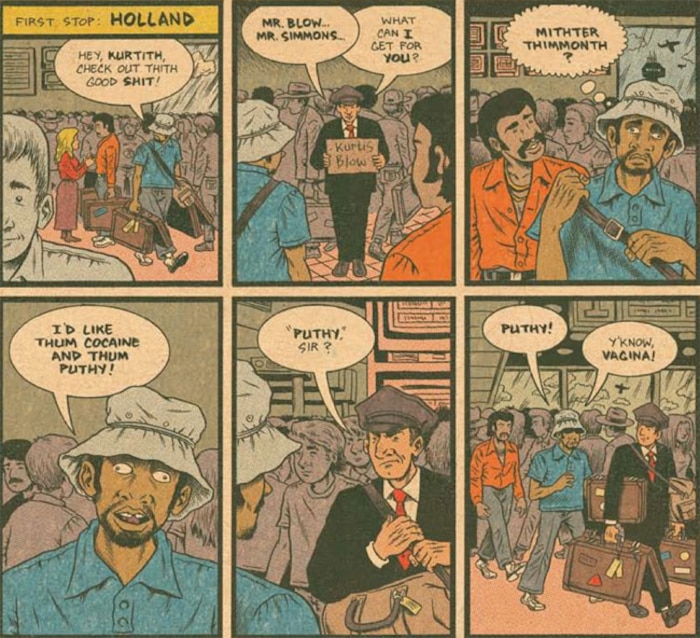
Yet, with some characters, you pull no punches in terms of depicting negative traits. The early Russell Simmons, for example, who is nowadays best known for being a rather Zen person.
Here’s the thing: Early Russell Simmons was a kooky guy, and admittedly on every drug there was. Did you ever see that Tougher Than Leather Run-D.M.C. movie, directed by Rick Rubin? You can’t tell me that his eyeballs are not fucked-up. [laughs] And, he happened to have a crazy lisp. Now, my comic is not a biography of these individual people. My main character in the comic is hip hop in general. And if I’m blessed with good health and I can keep this story going for as long as I envision it, you will see the maturation of some of the characters involved, especially some of the characters who really stood the test of time. Russell Simmons is one of those guys. Later in life he becomes a more enlightened, Buddhist kind of guy. You’re gonna watch him grow, and the same goes for the Beastie Boys, you’re gonna watch them grow. But let’s not pretend these guys were not knuckleheads at the beginning. As for Licensed To Ill, you will see that they played around with the idea of calling the album Don’t Be a Faggot. And we all know these are the same guys who organized the Tibetan freedom concert and stuff like that. But they started from an immature place.
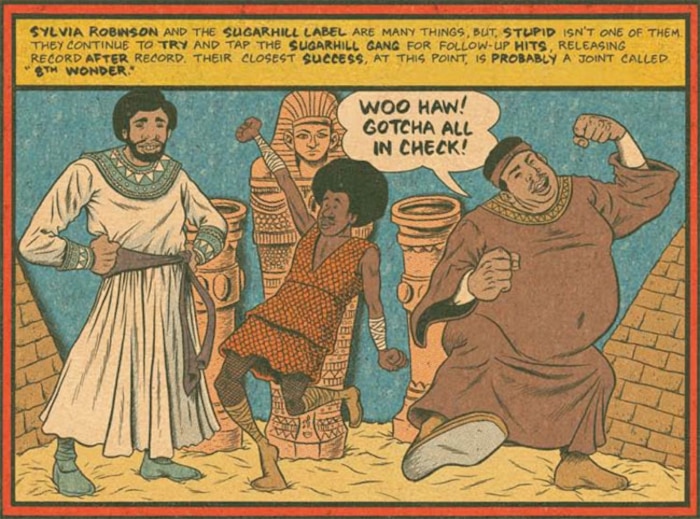
Would you agree that there are several occasions in which you as the dominant narrative voice decide to side with the artists, rather than with the industry types, such as Sylvia Robinson of Sugarhill Records?
Uhm, a little column A, a little column B here. Just being a cartoonist who works with publishers, my business model for how I’m able to do what I do is the exact same as for a musician. It’s probably on a way smaller scale, with less money involved for cartoonists, but I can see how publishers can fake numbers and say that they sold 10,000 units less so they can keep this money. And you’re none the wiser. What are you gonna do, sue them and audit their books? That’s gonna cost you more than you would make with the actual payment.
I side with the creatives on that end because I get nervous about the money people. They are like the cultural gatekeepers. There are lots of these early hip hop people who didn’t go on through the years because they just weren’t making money. So these record labels inhibited culture because who is to say that, say, Cowboy didn’t have a great solo record for himself? In that matter, I do side with the artist, no doubt. However, doing my research, there’s literally not one person who had anything good to say about the financial structures of Enjoy Records or Sugarhill. There’s not one person, maybe Big Bank Hank, but he was just not saying anything.
That’s a different topic, I guess, Hank was maybe the biggest beneficiary of the whole Sugarhill situation, as he didn’t write any of his lyrics himself.
“Early Russell Simmons was a kooky guy, and admittedly on every drug there was.”
Exactly, it was all down to the other two guys in Sugarhill Gang, Wonder Mike and Master Gee, and I think Melle Mel wrote a couple of Hank’s rhymes here and there. They all clowned him like, “This guy can’t even hold rhythm, he is so wack!” [laughs] There’s a documentary that might be out, or still looking for distribution I can’t remember, about Wonder Mike and Master Gee trying to reclaim their names. Because there would be these Sugarhill Reunion shows and it would be advertised as the real Sugarhill Gang, in which Sylvia Robinson’s son would take the mantle of Master Gee, doing his rhymes. A rather bizarre business move of Sylvia to buy everybody’s names… you know after Lil Rodney C and KK Rockwell left Funky Four Plus One, Funky Four Plus One records were still coming out. Because she owned those names. Grandmaster Flash, for example, had to fight for his in court.
Which brings us back to the naiveté of the early hip hop scene. No one was business-savvy, because no one had any firsthand experience with the industry side of things.
Exactly, it was all youthful optimism and I think that comes through with the records. When you listen to those old Enjoy Records, “Rappin and Rocking The House,” “Superrappin” or “New Rap Language,” these are records that were almost ten minutes long. And they give me the impression that everyone involved thought that this might have been their one shot. The records are so packed with content. It’s interesting taking into account that these people were doing live shows and performances for years before they even got this chance. So they had the opportunity to test all these lyrics in a hostile environment, where people might punch you in the jaw if you were wasting their money. So each of these performers knew what their best material was and packed those early records with all that material. It’s great. I could cry thinking about it, because all of these songs are like a Hail Mary pass, where you have this one shot and you have to pray that it goes down and is successful – or you’re done. There is a real optimism and hope, and it makes you think of all they had to overcome to have this opportunity. You could feel the excitement in their voices.